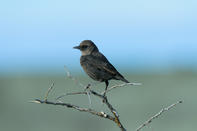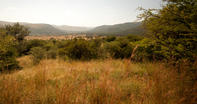Outrageous Displays
The Suikerbosrand Nature Reserve near Nigel covers 13 337 ha of hilly and, in places, craggy grassland, with some scrub and bush in the sheltered valleys and kloofs. The more hilly terrain in the east of the reserve is characterised by protea veld, the dominant species being the common sugarbush or 'suikerbossie' (Protea caffra), after which this range is named.

As would be expected, the most common birds in the reserve are typical grassveld species such as cisticolas, larks, pipits and chats, but it is the otherwise bland widow birds and whydahs, which put on outrageous displays of breeding plumage from spring to early summer, that are the most attractive.
As well as birds, mammals such as springbok, blesbok, zebra and black wildebeest are likely to be seen, plus herds of red hartebeest. In places where the grass is rank shy oribi will lie up, breaking cover only at the last minute.
You will then learn why the species is endangered: they will bound off for about 50 m, then stop and turn to look back at you. This behaviour makes them an easy target for even a poor shot. Reedbuck (which, together with springbok are the cheetah's favourite dinner) often do the same, except they frequent a more concealing habitat. Be on the lookout for eland, for they seem to favour the edge of wooded areas during the day.
The thornveld and grassland mosaic is the place where paradise whydahs, often confused with longtailed widows by novice bird-watchers, are found (pintailed whydahs are quite common in the montane grasslands). Also found in the bushveld-type habitat are black and doublecollared sunbirds, plum-coloured starlings, Jacobin and red-chested cuckoos (the Piet-my-vrou), honeyguides, barbets and paradise flycatchers.
Highveld Plains

The Suikerbosrand is a range of low hills, about 50 km south of the similar Witwatersrand range. The main difference between the two is, apart from about 4 million people and 400 million years, that the Suikerbosrand does not have any of the sparkling streams that gave their name to the more northerly ridge where gold was found.
Geologically they are quite different: the Witwatersrand is a complex group of very old (600 to 700 million years old) quartzites, conglomerates, banded ironstones and shales, while the Suikerbosrand comprises much younger (about 250 million years old) Karoo period dolerite intrusions.
The Cape Fynbos, forests and wetlands are well-known as being endangered habitats, but the open Highveld plains are fast being gobbled up by urban expansion, where they have not already been ploughed under to maize. In its natural state this veld type is as rich and attractive as any other.
By David Bristow